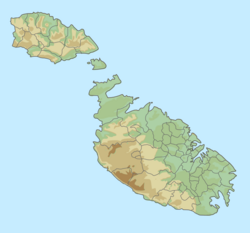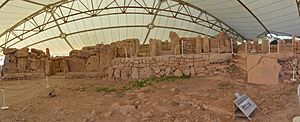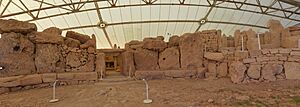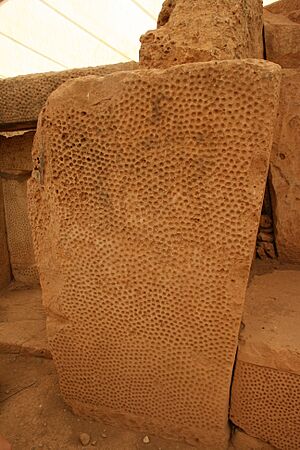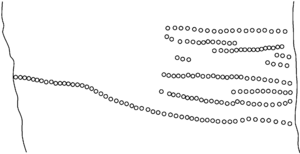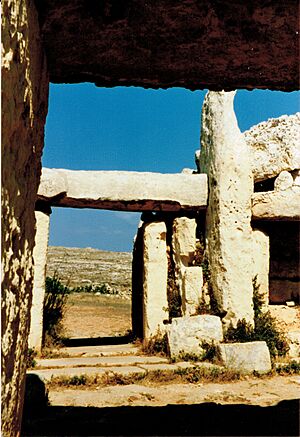Mnajdra facts for kids
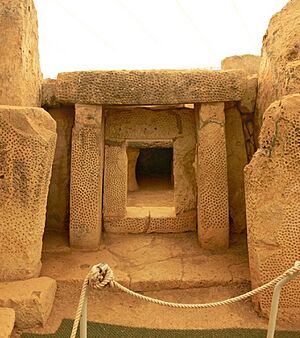
Niche at the Mnajdra South Temple
|
|
| Location | Qrendi, Malta |
|---|---|
| Coordinates | 35°49′36″N 14°26′11″E / 35.82667°N 14.43639°E |
| Type | Temple |
| History | |
| Material | Limestone |
| Founded | c.3600 BC–c.3200 BC |
| Periods | Ġgantija phase Tarxien phase |
| Site notes | |
| Excavation dates | 1840–1954 |
| Archaeologists | J. G. Vance Themistocles Zammit John Davies Evans |
| Condition | Well-preserved ruins |
| Ownership | Government of Malta |
| Management | Heritage Malta |
| Public access | Yes |
| UNESCO World Heritage Site | |
| Part of | Megalithic Temples of Malta |
| Criteria | Cultural: (iv) |
| Inscription | 1980 (4th Session) |
| Extensions | 1992, 2015 |
| Area | 0.563 ha (60,600 sq ft) |
Mnajdra (which means L-Imnajdra in Maltese) is a group of very old stone temples. You can find them on the southern coast of the island of Malta in the Mediterranean Sea. Mnajdra is about 500 meters away from another ancient temple site called Ħaġar Qim.
These temples were built a very long time ago, around 3600 to 3200 BC. That's over 5,000 years ago! The ancient temples of Malta, including Mnajdra, are some of the oldest religious places on Earth. Experts call them "unique architectural masterpieces." In 1992, UNESCO added Mnajdra and other Maltese stone structures to its list of World Heritage Sites. This means they are very important places that need to be protected. In 2009, a special tent was built over the temples to help protect them from the weather.
Contents
Exploring the Mnajdra Temples
The Mnajdra temples are built from a type of stone called coralline limestone. This stone is very strong and hard. The builders used two main ways to construct the temples. One way was called corbelling, where they stacked smaller stones, each sticking out a little further than the one below, to create a roof or arch. The other way was post and lintel, which means they used large, upright stone slabs (posts) with another large slab laid across the top (lintel).
The layout of Mnajdra looks like a cloverleaf. It seems more organized than the nearby Ħaġar Qim temples. The site has three temples that are joined together but don't connect inside. These are called the upper, middle, and lower temples.
The Oldest Temple: Upper Mnajdra
The upper temple is the oldest part of the Mnajdra complex. It was built between 3600 and 3200 BC. This temple has three rounded rooms, called apses. The opening to the middle room is partly blocked by a low stone wall. Some of the tall stone pillars inside have small holes drilled into them in neat rows.
The Middle Temple
The middle temple was built or rebuilt later, between 3150 and 2500 BC. Its main entrance is a hole cut into a large, upright piece of limestone. This type of doorway is common in other ancient Maltese temples. This temple might have once had a curved, vaulted ceiling, but only the bottom parts of it remain on top of the walls today.
The Most Impressive Temple: Lower Mnajdra
The lowest temple was built in an earlier period, but it is often considered the most impressive. It's a great example of ancient Maltese building skills. It has a large open area in front with stone benches. The entrance passage was covered by flat stone slabs, and one of these still remains. It might have even had a domed roof at one point. This temple is decorated with cool spiral carvings and dents. It also has windows, some leading to smaller rooms, and one looking out onto a special arrangement of stones.
What Were the Temples Used For?
The lowest temple at Mnajdra is special because it lines up with the sun and stars. This means it was probably used to watch the sky or to keep track of the calendar.
- On the first day of spring and the first day of autumn (called the equinoxes), sunlight shines right through the main doorway and lights up the main path inside the temple.
- On the longest day of summer and the shortest day of winter (called the solstices), the sun's rays light up the edges of the big stones on either side of the doorway.
Even though we don't have written records from that time, archaeologists have found clues about how the temples were used. They found things like flint knives and holes that might have been used to hold animals for sacrifice. Animal bones were also found. However, no human remains were found, so these temples were not used as tombs. The temples also have stone benches and tables, which give us hints about their purpose. Many items found inside suggest that these temples were used for religious ceremonies, perhaps to ask for healing or to help crops grow and animals have babies.
The Calendar Stone
One of the stones at Mnajdra has many drilled holes arranged in different rows. Scientists think these holes might have been used as a calendar, possibly to track the moon's cycles.
| Row | Number of holes | Possible use |
|---|---|---|
| 1 | 19 | For the 19 years of the Metonic cycle. After this time, the moon is in the same phase and position in the sky. |
| 2 | 16 (right) | For the 16 days from the old moon until the full moon, and 13 days from the full moon until the next old moon. Together, this is 29 days, which is about how long a moon cycle (synodic month) lasts. |
| 13 (left above) | ||
| 3 | 3 + 4 (right) = 7 |
For the 7 full days in a moon quarter or a week. |
| 3 (left) | For the 3 moon quarters that have already passed in the current month. | |
| 4 | 25 | For the 25 times the moon grows or shrinks (each about 14.8 days) within a year (365.2 days). |
| 5 | 11 | For the 11 extra days in a year (365.2 days) compared to twelve moon cycles (354.4 days). |
| 6 | 24 + 1 = 25 |
For the 24 times the moon grows or shrinks within twelve moon cycles (354.4 days), plus a part of a month until the end of the year (365.2 days). |
| 7 | 53 | For the 53 weeks in a year (365.2 days), or from one time a star group like the Pleiades appears in the sky to the next. |
Discoveries and Recent History
The first excavations (digs) at the Mnajdra temples happened in 1840. This was just one year after the nearby Ħaġar Qim temples were found. Many archaeologists have studied the site over the years. In 1910, Thomas Ashby found important ancient items there. Later, in 1949, more digs uncovered two small statues, two large bowls, tools, and a big round stone. This round stone was probably used to help move the huge stones of the temple.
Mnajdra was sadly damaged by vandals in 2001. About 60 large stones were pushed over or broken, and graffiti was written on them. UNESCO called it "the worst act of vandalism ever committed on the island of Malta." At first, people thought the damage couldn't be fixed. But, using new methods, the temples were restored, and it's now hard to see where the damage was. The temples reopened to visitors in 2002.
Since 2008, pictures of the Mnajdra temples have been on the 1, 2, and 5 cent Maltese euro coins. In 2009, a large protective shelter was built over Mnajdra (and Ħaġar Qim) to keep them safe from the weather.
Images for kids
-
.
Solar angles
-
.
Map of the Mnajdra temple
See also
- Ġgantija
- Ħaġar Qim
- Hypogeum of Ħal-Saflieni
- List of megalithic sites
- Tarxien Temples


